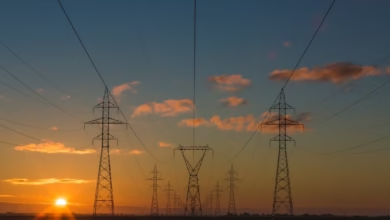Navigating Global Energy Trade: Understanding Energy Exports, Imports, and the Transition to Renewables

In an increasingly interconnected world, the dynamics of global energy trade have become more critical than ever. As countries strive to meet their energy needs while addressing climate change, the conversation surrounding energy exports and imports has evolved significantly. This article delves into the complex landscape of energy resources, highlighting the key factors that influence energy markets today. We will explore how the energy transition is reshaping the balance between renewable energy and fossil fuels, as nations pivot towards greener alternatives like solar power, wind energy, and hydropower. Additionally, we will examine the role of innovations in energy security, including smart grids and energy storage, which are crucial in navigating the challenges posed by fluctuating energy demands and supply. By understanding these global energy trends, policymakers and investors can better navigate the evolving energy economics and ensure a sustainable future. Join us as we unpack the intricacies of energy trade, highlighting the importance of energy efficiency, carbon capture technologies, and the rise of distributed energy systems in the quest for a resilient energy landscape.
- 1. The Dynamics of Global Energy Trade: Understanding Energy Exports and Imports
- 2. Renewable Energy vs. Fossil Fuels: Navigating the Energy Transition and Market Trends
- 3. Innovations in Energy Security: The Role of Smart Grids and Energy Storage in Global Trade
1. The Dynamics of Global Energy Trade: Understanding Energy Exports and Imports
The dynamics of global energy trade are influenced by a complex interplay of various factors, including supply and demand, technological advancements, and geopolitical considerations. Energy exports and imports play a vital role in shaping the landscape of energy markets, where countries seek to secure their energy needs while also capitalizing on their energy resources.
As nations transition towards renewable energy sources, the significance of energy exports and imports has evolved. Countries rich in fossil fuels, such as oil and natural gas, continue to dominate energy exports; however, the rise of renewable energy technologies, like solar power and wind energy, is shaping new trade patterns. Many nations are investing in energy storage solutions to optimize the use of renewable sources, ensuring a stable supply even when the sun isn't shining or the wind isn't blowing.
Energy efficiency is increasingly becoming a focal point within energy policy discussions. Countries are recognizing the importance of reducing energy consumption while improving energy security. This has led to innovations in energy management, including smart grids that enhance energy transportation and distribution. The integration of electric vehicles into the energy market also contributes to changing energy consumption patterns, creating new demands for renewable energy and altering the dynamics of energy imports and exports.
The energy transition is prompting countries to explore diverse energy resources, such as hydropower and bioenergy, while also investing in nuclear energy and thermal energy. Hydrogen energy is gaining attention as a versatile energy carrier, with potential applications in various sectors, further influencing global energy economics. Additionally, energy investments in carbon capture technologies are becoming essential for mitigating climate change impacts, encouraging a shift towards cleaner energy systems.
Energy R&D plays a crucial role in advancing energy innovations that drive the global energy trends. As nations strive to fulfill their commitments to climate goals, the need for distributed energy resources is more pronounced. This trend not only enhances energy security by decentralizing energy production but also fosters resilience against market volatility.
In summary, the dynamics of global energy trade are continuously evolving, shaped by technological advancements, changing consumer preferences, and the urgent need to address climate change. Understanding these factors is essential for policymakers and stakeholders as they navigate the complexities of energy exports and imports in an increasingly interconnected world.
2. Renewable Energy vs. Fossil Fuels: Navigating the Energy Transition and Market Trends
The shift from fossil fuels to renewable energy sources marks a significant turning point in the global energy landscape, driven by the urgent need to address climate change and enhance energy security. As nations grapple with energy policies designed to support sustainable development, the energy transition has become a focal point for energy markets worldwide.
Renewable energy, including solar power, wind energy, hydropower, and bioenergy, presents a sustainable alternative to traditional fossil fuels such as coal, oil, and natural gas. This transition is not merely a trend but a necessity, as fossil fuels contribute significantly to greenhouse gas emissions and climate change. The integration of renewable energy into energy systems is bolstered by innovations in energy storage and energy efficiency, paving the way for a more resilient and adaptable energy infrastructure.
Moreover, the rise of nuclear energy and thermal energy as part of the energy mix provides additional avenues for reducing reliance on fossil fuels. Nuclear energy, while controversial, offers a low-carbon option that can help stabilize energy supply during the transition. Similarly, thermal energy systems, when combined with carbon capture technologies, can significantly reduce emissions from existing fossil fuel operations.
The growing demand for electric vehicles further underscores the importance of transitioning to renewable energy. As more consumers adopt electric vehicles, the need for clean energy sources to power these vehicles will intensify, pushing energy markets to innovate and adapt. Smart grids and distributed energy systems will play a pivotal role in managing this increased demand and enhancing energy transportation efficiency.
In this evolving landscape, energy investment is critical. Governments and private entities are focusing on energy R&D to advance technologies that support the energy transition. The emergence of hydrogen energy as a clean fuel source offers promising potential for decarbonizing various sectors, including transportation and industrial processes.
As we navigate these global energy trends, the importance of energy exports and imports cannot be overstated. Countries rich in renewable resources are positioning themselves as leaders in energy exports, while others may rely on energy imports to meet their growing demands. This interdependence highlights the need for robust energy policies that promote not only energy security but also the sustainability of the planet.
Ultimately, the energy transition represents a complex interplay of market forces, technological advancements, and policy decisions, all aimed at fostering a cleaner, more sustainable energy future. Embracing renewable energy while managing the decline of fossil fuels will be crucial in achieving long-term climate goals and ensuring a stable energy economy.
3. Innovations in Energy Security: The Role of Smart Grids and Energy Storage in Global Trade
The transformation of global energy markets is significantly influenced by innovations in energy security, particularly through the implementation of smart grids and advancements in energy storage technologies. As countries transition from fossil fuels to renewable energy sources, energy efficiency and security become paramount in ensuring a stable energy supply for both exports and imports.
Smart grids play a crucial role in enhancing energy security by integrating diverse energy resources, including solar power, wind energy, and hydropower, into a cohesive energy network. These intelligent systems enable real-time monitoring and management of energy flows, facilitating the seamless distribution of green energy across regions. By improving the reliability of energy transportation, smart grids help mitigate the risks associated with energy shortages and fluctuations in energy supply, which are critical in today’s volatile energy markets.
Energy storage technologies are equally vital in supporting the energy transition. They enable the capture and storage of excess energy generated from renewable sources, such as solar and wind, for later use. This capability not only enhances energy efficiency but also stabilizes the grid, ensuring that energy demands are met even during periods of low generation. Furthermore, innovations in hydrogen energy and battery storage systems present new opportunities for countries to bolster their energy security, allowing for the effective integration of intermittent renewable resources.
The synergy between smart grids and energy storage is pivotal in shaping energy policy and driving energy investments. As nations prioritize sustainable energy solutions to combat climate change, the demand for robust energy innovations that enhance energy security will continue to rise. The ability to efficiently manage and store energy not only supports energy imports and exports but also fosters resilience in the face of global energy trends and economic fluctuations.
In conclusion, as we navigate the complexities of the global energy landscape, the integration of smart grids and advanced energy storage solutions will be instrumental in ensuring a secure, efficient, and sustainable energy future. These innovations not only protect against supply disruptions but also facilitate the broader adoption of renewable energy, thereby playing a vital role in the ongoing energy transition.
In conclusion, the global trade of energy resources is a complex and dynamic landscape shaped by the interplay of energy imports and exports, market trends, and evolving technologies. As we navigate the energy transition, the competition between renewable energy sources and fossil fuels has become a focal point for energy policy and investment. Innovations such as smart grids and energy storage are pivotal in enhancing energy security and efficiency, allowing countries to better manage their energy resources amid the challenges posed by climate change.
Moreover, the diversification of energy markets through investments in hydropower, bioenergy, and emerging technologies like hydrogen energy and carbon capture is vital for achieving a sustainable energy future. As countries continue to adapt their energy strategies to embrace green energy solutions, the role of thermal energy and offshore energy resources will also be significant in meeting global demand.
Ultimately, understanding global energy trends and the intricacies of energy economics will be crucial for stakeholders in the energy sector. As we move forward, fostering advancements in energy R&D and promoting distributed energy solutions will help create a resilient, efficient, and sustainable energy landscape that benefits both economies and the environment. By embracing these innovations and prioritizing energy efficiency, we can ensure a more secure energy future that aligns with global climate goals.





